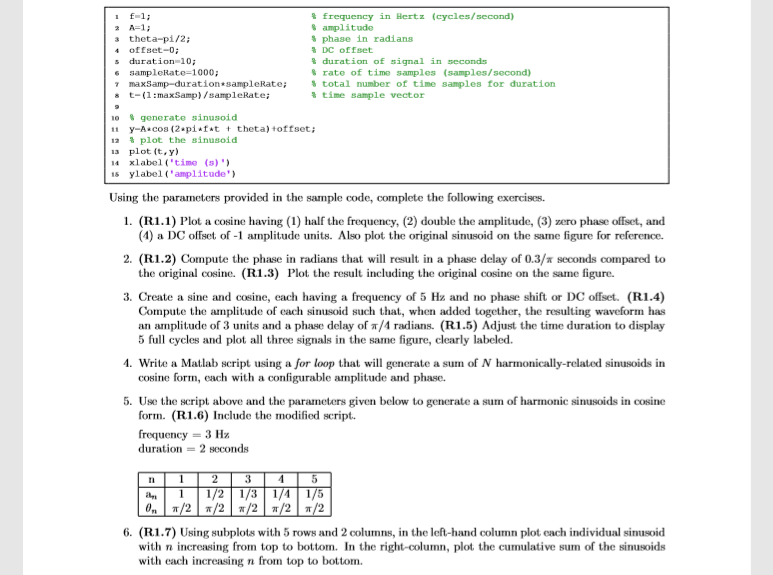Question
MATLAB help: I need help solving part 4,5 and 6. I already have the first 3 parts. R1.1) clc clear all f=1/2; A=2; theta=0; offset=-1;
MATLAB help:
I need help solving part 4,5 and 6. I already have the first 3 parts.
R1.1)
clc clear all f=1/2; A=2; theta=0; offset=-1; duration=10; sampleRate=1000; maxSamp=duration*sampleRate; t=(1:maxSamp)/sampleRate;
y1=A*cos(2*pi*f*t+theta)+offset; A=1; f=1 theta=pi/2; offset=0; y2=A*cos(2*pi*f*t+theta)+offset; plot(t,y1,'b',t,y2,'r'); xlabel('time(s)'); ylabel('amplitude'); legend('R(1.1)','Original');
--------
(R1.2)
clc clear all f=1; A=1; theta=pi/2; offset=0; duration=10; sampleRate=1000; maxSamp=duration*sampleRate; t=(1:maxSamp)/sampleRate;
y1=A*cos(2*pi*f*t+theta)+offset; theta=-0.3/pi; y2=A*cos(2*pi*f*t+theta)+offset; plot(t,y1,'b',t,y2,'r'); xlabel('time(s)'); ylabel('amplitude'); legend('R(1.2)','Original');
--------------------------------
R1.3)
clc clear all f=5; A=-3/(sqrt(2)); theta=0; offset=0; duration=2; sampleRate=1000; maxSamp=duration*sampleRate; t=(1:maxSamp)/sampleRate;
y1=A*cos(2*pi*f*t+theta)+offset; A=3/(sqrt(2)); y2=A*sin(2*pi*f*t+theta)+offset; y3=y1+y2; plot(t,y1,'b',t,y2,'r'); hold on; plot(t,y3,'g') xlabel('time(s)'); ylabel('amplitude'); legend('R(1.3) sine','R(1.3) cose','Combined');

Step by Step Solution
There are 3 Steps involved in it
Step: 1

Get Instant Access to Expert-Tailored Solutions
See step-by-step solutions with expert insights and AI powered tools for academic success
Step: 2

Step: 3

Ace Your Homework with AI
Get the answers you need in no time with our AI-driven, step-by-step assistance
Get Started


